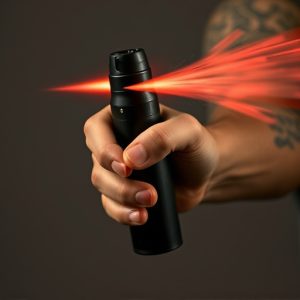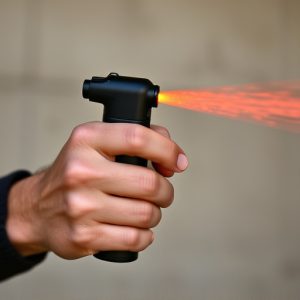Pepper Spray Defense Against Dogs: Components, Safety, Legalities, and Efficacy
Pepper spray, primarily used for human self-defense, can also deter aggressive dogs due to its activ…….
Pepper spray, primarily used for human self-defense, can also deter aggressive dogs due to its active ingredient capsaicin. Riot control spray dispensers are designed for large gatherings and civil unrest, offering precise targeting against canines. While effective, its variability in high-stress situations and against large dog breeds requires caution from owners. Legalities vary; understanding local laws, proper storage, and training on usage techniques are crucial for responsible use, balancing individual rights and safety in the context of pepper spray as a defense against dogs.
“Uncover the power of pepper spray as a defense mechanism against aggressive dogs with this comprehensive guide. We explore its efficacy, delving into how this non-lethal force tool works, particularly against canine adversaries. From understanding the science behind pepper spray’s effects to navigating legal considerations, we equip dog owners with knowledge. Learn about the key components and safety measures of riot control spray dispensers, ensuring effective yet responsible protection for both pets and people.”
- Understanding Pepper Spray and Its Efficacy Against Dogs
- Components and Mechanism of a Riot Control Spray Dispenser
- Usage and Safety Considerations for Dog Owners
- Legal Implications and Availability of Pepper Spray for Personal Defense
Understanding Pepper Spray and Its Efficacy Against Dogs
Pepper spray, a non-lethal self-defense tool, has gained popularity for its effectiveness against human aggressors. However, its use against dogs is a topic of interest and concern. When faced with an attack from a canine, pepper spray can be a game-changer, providing a momentary defense to escape or de-escalate the situation. The active ingredient, capsaicin, stimulates nerve endings, causing temporary blindness, coughing, and difficulty breathing in both humans and dogs.
In terms of Pepper Spray Defense Against Dogs, studies show that pepper spray can be highly effective when used correctly. Its potency disrupts the dog’s sense perception, allowing the owner or victim time to retreat or summon help. However, it’s crucial to understand that not all dogs react similarly; factors like breed, size, and temperament play a role. Additionally, proper usage techniques are essential to ensure the spray reaches the canine’s eyes and respiratory system for maximum efficacy.
Components and Mechanism of a Riot Control Spray Dispenser
Riot control spray dispensers are designed to effectively manage and disrupt chaotic situations, often characterized by large gatherings or protests. These devices typically consist of several key components: a pressurized container, a mechanism for dispensing the solution, and various nozzles or diffusers to ensure optimal distribution. The primary active ingredient in most cases is oleoresin capsicum (OC), more commonly known as pepper spray, which has been extensively studied for its non-lethal effects on both humans and animals.
The mechanism behind these dispensers involves releasing a highly concentrated solution of OC mixed with other additives like chemicals to enhance visibility or cause temporary blindness. When activated, the dispenser expels the spray through narrow nozzles, allowing for precise targeting. This chemical defense is particularly effective against dogs, as pepper spray irritates their eyes and respiratory system, providing a crucial layer of protection for individuals in high-risk environments, such as law enforcement officers dealing with aggressive canines during riots or civil unrest.
Usage and Safety Considerations for Dog Owners
Dog owners considering a pepper spray defense against dogs should approach it with caution and an understanding of its limitations. While pepper spray can deter and incapacitate an aggressive dog, it’s crucial to recognize that it may not always be effective, especially in certain situations like high-stress scenarios or when dealing with large, powerful breeds. Usage should be limited to self-defense against dogs displaying unprovoked aggression or as a last resort during a hostile encounter.
Safety is paramount. Dog owners must familiarize themselves with local laws regarding the possession and use of pepper spray, ensuring they comply with regulations related to self-defense products. Proper storage and handling of the dispenser are essential to prevent accidental activation. Additionally, regular training on usage techniques can help owners employ the spray effectively while minimizing harm to both the dog and any bystanders.
Legal Implications and Availability of Pepper Spray for Personal Defense
The use of pepper spray, also known as oleoresin capsicum (OC) spray, for personal defense is a controversial topic with significant legal implications. While many advocate for its potential to deter and control aggressive animals like dogs, its availability and use are strictly regulated in many jurisdictions. In some regions, citizens may legally carry pepper spray for self-defense against dogs or other threats, but permits or training certifications might be required. This legislation varies widely, with certain areas allowing only law enforcement or specific individuals trained in its safe handling to possess it.
The debate revolves around balancing individual rights and safety with community concerns about misuse and accidental injuries. Proponents argue that pepper spray can provide a non-lethal means of self-defense against dogs, offering a crucial tool for personal protection during encounters in remote areas or when facing aggressive pets. However, critics worry about the potential for abuse, cross-contamination, and harm to bystanders or animals not intended as targets. As such, understanding local laws and regulations regarding pepper spray ownership and use is essential for anyone considering it as a defense mechanism against dogs or other potential threats.
Pepper spray, as a personal defense mechanism against dogs, has shown effectiveness in deterring aggressive encounters. However, it’s crucial for dog owners to understand the proper usage and safety measures of riot control spray dispensers. By familiarizing themselves with the components and legal implications, they can make informed decisions regarding its use. Remember, while pepper spray can be a game-changer in potentially dangerous situations, responsible handling is key to ensuring its efficacy as a defense against dogs without causing harm to humans or other animals.


